(→1970s) |
m |
||
| (30 intermediate revisions by 10 users not shown) | |||
| Line 1: | Line 1: | ||
| − | + | Throughout the years, [[microprocessor]]s have played a large role in spacecrafts. [[space-qualified microprocessor]]s are designed to be exceptionally reliable and [[radiation hardening|highly durable]]. Due to their unique nature, the same set of chips that have been tested and proven to work are used in many spacecrafts. Below is a list of '''microprocessors used in spacecraft'''. | |
| + | |||
| + | |||
| + | <div class="htoc notoctitle nonumtoc center">__TOC__</div> | ||
| + | == 1950s == | ||
| + | {| class="wikitable" | ||
| + | |- | ||
| + | ! Year !! Picture !! Spacecraft !! Chipset | ||
| + | |- | ||
| + | | rowspan="2" | 1959-1963 || rowspan="2" | [[File:Mercury Friendship7 Bassett Celestia.jpg|200px]] || rowspan="2" | [[Wikipedia:Mercury spacecraft|Mercury spacecraft]] || style="text-align: center;" | None | ||
| + | |- | ||
| + | | '''Description''': The [[Wikipedia:Mercury spacecraft|Mercury spacecraft]], NASA's first human spaceflight, had barely enough space for a single occupant. The spacecraft had no independent maneuvering capabilities - relying completely on the Atlas booster rocket. Because of that, it was unnecessary for the spacecraft to have a dedicated on-board computer. Limited functionality was done by various smaller systems. | ||
| + | |} | ||
| + | == 1960s == | ||
| + | {| class="wikitable" | ||
| + | |- | ||
| + | ! rowspan="2" | Year !! rowspan="2" | Picture !! rowspan="2" | Spacecraft !! colspan="5" | Chipset | ||
| + | |- | ||
| + | ! style="width: 25%;" | System !! Processor !! Frequency !! Memory !! Weight | ||
| + | |- | ||
| + | | rowspan="2" | 1962-1966 || rowspan="2" | [[File:Gemini spacecraft.jpg|200px]] || rowspan="2" | [[Wikipedia:Gemini Spacecraft|Gemini Spacecraft]] || [[Gemini Guidance Computer]] || [[discrete logic|discrete IC]] RTL || 7.143 kHz || 19.5 KB || 58.98 lb | ||
| + | |- | ||
| + | | colspan="5" | The [[Wikipedia:Gemini Spacecraft|Gemini Spacecraft]] was part of Project Gemini, NASA's second human spaceflight program. | ||
| + | |- | ||
| + | | rowspan="2" | 1961-1972 || rowspan="2" | [[File:Apollo CSM lunar orbit.jpg|200px]] || rowspan="2" | [[Wikipedia:Apollo spacecraft|Apollo spacecraft]] || [[Apollo Guidance Computer]] || [[discrete logic|discrete IC]] RTL || 2.048 MHz || 4 KB (RAM)<br />73.73 KB (ROM) || 70 lb | ||
| + | |- | ||
| + | | colspan="5" | The [[Wikipedia:Apollo spacecraft|Apollo spacecraft]] was part of the [[Wikipedia:Apollo program|Apollo program]], NASA's third human spaceflight program. | ||
| + | |} | ||
== 1970s == | == 1970s == | ||
| Line 6: | Line 33: | ||
! Year !! Picture !! Spacecraft !! Description | ! Year !! Picture !! Spacecraft !! Description | ||
|- | |- | ||
| − | | 1971 || rowspan="2" | [[File:Pioneer 10-11 spacecraft.jpg|200px]] || [[Wikipedia:Pioneer 10|Pioneer 10]] || The [[Wikipedia:Pioneer 10|Pioneer 10]], which was launched on March 3, 1972, became the first spacecraft to achieve escape velocity from the Solar System. The spacecraft's process were made of individual [[transistor-transistor logic]] chips. A common myth is that the [[Intel 4004]] powered the Pioneer 10, this, | + | | 1971 || rowspan="2" | [[File:Pioneer 10-11 spacecraft.jpg|200px]] || [[Wikipedia:Pioneer 10|Pioneer 10]] || The [[Wikipedia:Pioneer 10|Pioneer 10]], which was launched on March 3, 1972, became the first spacecraft to achieve escape velocity from the Solar System. The spacecraft's process were made of individual [[transistor-transistor logic]] chips. A common myth is that the [[Intel 4004]] powered the Pioneer 10, however, this is incorrect. |
| + | |- | ||
| + | | rowspan="2" | 1973 || [[Wikipedia:Pioneer 11|Pioneer 11]] || The [[Wikipedia:Pioneer 11|Pioneer 11]], was launched on April 6, 1973 in order to study the [[Wikipedia:Asteroid belt|Asteroid belt]]. Just like it's twin probe, the Pioneer 10, its CPU was also a custom-designed [[transistor-transistor logic|TTL]] CPU. | ||
| + | |- | ||
| + | | [[File:Skylab (SL-4).jpg|200px]] || [[Wikipedia:Skylab|Skylab]] || The [[Wikipedia:Skylab|Skylab]], which was launched on May 14, 1973, and operated until 1979, used an [[IBM System/4Pi]] model TC-1 (Tactical Computer), a miniaturized and hardened version of the [[IBM System/360]] computers. | ||
| + | |- | ||
| + | | rowspan ="2" | 1975 || rowspan="2" | [[File:Viking spacecraft.jpg|200px]] || [[Wikipedia:Viking 1|Viking 1]] || rowspan="2" | The [[Wikipedia:Viking 1|Viking 1]], the first of two spacecrafts, was launched on August 20, 1975. The [[Wikipedia:Viking 2|Viking 2]], was launched a year later on September 9, 1975 The computer on-board the Viking Orbiter was the [[Viking Orbiter CCS]], a custom 18-bit TTL computer designed by General Electric. The lander computers, the [[Guidance, Control and Sequencing Computer]], used two [[Honeywell HDC 402]] microprocessors. (A common myth is that the Viking used an [[RCA 1802]], this is incorrect). | ||
| + | |- | ||
| + | | [[Wikipedia:Viking 2|Viking 2]] | ||
| + | |- | ||
| + | |- | ||
| + | | rowspan ="2" | 1977 || rowspan="2" | [[File:Voyager spacecraft.jpg|200px]] || [[Wikipedia:Voyager 1|Voyager 1]] || rowspan="2" | The [[Wikipedia:Voyager 1|Voyager 1]] and its sister craft [[Wikipedia:Voyager 2|Voyager 2]] were launched on September 5 and August 20 of 1977 and are still operating to date (2014). On August 25, 2012, NASA announced that Voyager 1 entered interstellar space. | ||
| + | |||
| + | Each craft carries three dual-redundant computer systems. The first one, the [[Voyager Command and Control Subsystem]] (CCS), was in charge of general spacecraft sequencing and general health functionality. The second one, the [[Voyager Attitude and Articulation Control Subsystems]] (AACS) used a slight variation of the CCS. The third computer was the [[Voyager Flight Data System|Voyager's data computer]], which was a custom 4-bit CMOS microprocessor. | ||
| + | |- | ||
| + | | [[Wikipedia:Voyager 2|Voyager 2]] | ||
| + | |} | ||
| + | |||
| + | == 1980s == | ||
| + | {| class="wikitable" | ||
| + | |- | ||
| + | ! Year !! Picture !! Spacecraft !! Description | ||
| + | |- | ||
| + | | 1981-2011 || [[File:STS129 Atlantis ride to orbit.jpg|200px]] || [[Wikipedia:Space Shuttle|Space Shuttle]] || The [[Wikipedia:Space Shuttle|Space Shuttles]] uses 5 identical (for redundancy) 32-bit [[IBM APA-101|IBM APA-101S]] microprocessors. The shuttle system was called the [[Space Shuttle Program Data Processing System |Data Processing System]] which was composed of [[Space Shuttle Program Primary Avionics Software System|Primary Avionics Software System]] (PASS), that ran in 4 of the computers and the [[Space Shuttle Backup Flight System|Backup Flight System]] on the fifth. | ||
| + | |- | ||
| + | | 1989 || [[File:Artwork Galileo-Io-Jupiter.JPG|200px]] || [[Wikipedia:Galileo (spacecraft)|Galileo]] || The Galileo spacecraft uses the [[Wikipedia:RCA_1802|RCA 1802]] CPU. | ||
| + | |} | ||
| + | |||
| + | == 1990s == | ||
| + | {| class="wikitable" | ||
| + | |- | ||
| + | ! Year !! Picture !! Spacecraft !! Description | ||
| + | |- | ||
| + | | 1990 || [[File:HST-SM4.jpeg|200px]] || [[Wikipedia:Hubble Space Telescope|Hubble Space Telescope]] || | ||
| + | |- | ||
| + | | rowspan="2" | 1991 || [[File:UARS 1.jpg|200px]] || [[Wikipedia:Upper Atmosphere Research Satellite|UARS]. The UARS spacecraft used the NASA Standard Spacecraft Computer (NSSC-1), although the various instruments probably had embedded microprocessors.] || | ||
| + | |- | ||
| + | | [[File:Cartoon CGRO.jpg|200px]] || [[Wikipedia:Compton Gamma Ray Observatory|CGRO]] || | ||
| + | |- | ||
| + | | rowspan="4" | 1992 || [[File:MSTI-1 drawing.gif|200px]] || [[Wikipedia:MSTI-1|MSTI-1]] || | ||
| + | |- | ||
| + | | [[File:SAMPEX 3.jpg|200px]] || [[Wikipedia:Solar Anomalous and Magnetospheric Particle Explorer|SAMPEX]] || | ||
| + | |- | ||
| + | | [[File:EUVE Photo.gif|200px]] || [[Wikipedia:Extreme Ultraviolet Explorer|EUVE]] || | ||
| + | |- | ||
| + | | [[File:TOPEX;Poseidon.jpg|200px]] || [[Wikipedia:TOPEX/Poseidon|TOPEX/Poseidon]] || | ||
| + | |- | ||
| + | | 1993 || || [[Wikipedia:PoSAT-1|PoSAT-1]] || | ||
| + | |- | ||
| + | | rowspan="2" | 1994 || [[File:MSTI-2.gif|200px]] || [[Wikipedia:MSTI-2|MSTI-2]] || | ||
| + | |- | ||
| + | | [[File:Clementine Deployed.gif|200px]] || [[Wikipedia:Clementine (spacecraft)|Clementine]] || | ||
| + | |- | ||
| + | | 1995 || || [[Wikipedia:MSTI-3|MSTI-3]] || | ||
| + | |- | ||
| + | | 1996 || [[File:FAST.jpg|200px]] || [[Wikipedia:Fast Auroral Snapshot Explorer|FAST]] || | ||
| + | |- | ||
| + | | rowspan="3" | 1997 || [[File:Mars Global Surveyor.jpg|200px]] || [[Wikipedia:Mars Global Surveyor|Mars Global Surveyor]] || | ||
| + | |- | ||
| + | | [[File:Sojourner on Mars PIA01122.jpg|200px]] || [[Wikipedia:Sojourner_(rover)|Mars Sojourner Rover]] || 80C85 CPU. | ||
| + | |- | ||
| + | | [[File:Cassini Saturn Orbit Insertion.jpg|200px]] || [[Wikipedia:Cassini–Huygens|Cassini–Huygens]] || | ||
| + | |- | ||
| + | | rowspan="4" | 1998 || [[File:International Space Station after undocking of STS-132.jpg|200px]] || [[Wikipedia:International Space Station|International Space Station]] || | ||
| + | |- | ||
| + | | [[File:Swas 1.jpg|200px]] || [[Wikipedia:Submillimeter Wave Astronomy Satellite|SWAS]] || | ||
| + | |- | ||
| + | | [[File:TRACE satellite.jpg|200px]] || [[Wikipedia:TRACE|TRACE]] || | ||
| + | |- | ||
| + | | [[File:Deep Space 1 using its ion engine.jpg|200px]] || [[Wikipedia:Deep Space 1|Deep Space 1]] || | ||
| + | |- | ||
| + | | rowspan="4" | 1999 || [[File:TERRA am1.jpg|200px]] || [[Wikipedia:Terra (satellite)|Terra]] || | ||
| + | |- | ||
| + | | [[File:Wire.jpg|200px]] || [[Wikipedia:Wide Field Infrared Explorer|WIRE]] || | ||
| + | |- | ||
| + | | || [[Wikipedia:UoSAT-12|UoSAT-12]] | ||
| + | |- | ||
| + | | [[File:FUSE 1.jpg|200px]] || [[Wikipedia:Far Ultraviolet Spectroscopic Explorer|FUSE]] || | ||
| + | |} | ||
| + | |||
| + | == 2000s == | ||
| + | {| class="wikitable" | ||
| + | |- | ||
| + | ! Year !! Picture !! Spacecraft !! Description | ||
| + | |- | ||
| + | | rowspan="2" | 2000 || || [[Wikipedia:Cluster II (spacecraft)|Cluster II]] || | ||
| + | |- | ||
| + | | [[File:Mightysat2.jpg|200px]] || [[Wikipedia:MightySat-2.1|MightySat-2.1]] || | ||
| + | |- | ||
| + | | 2001 || [[File:Genesis in collection mode.jpg|200px]] || [[Wikipedia:Genesis (spacecraft)|Genesis]] || | ||
| + | |- | ||
| + | | rowspan="2" | 2002 || [[File:Aqua satellite simulation.jpg|200px]] || [[Wikipedia:Aqua (satellite)|Aqua]] || | ||
| + | |- | ||
| + | | [[File:Rhessi.jpg|200px]] || [[Wikipedia:Reuven Ramaty High Energy Solar Spectroscopic Imager|RHESSI]] || | ||
| + | |- | ||
| + | | rowspan="5" | 2003 || [[File:NASA Mars Rover.jpg|200px]] || [[Wikipedia:Spirit Rover|Spirit Rover]] || | ||
| + | |- | ||
| + | | [[File:Opportunity PIA03240.jpg|200px]] || [[Wikipedia:Opportunity rover|Opportunity rover]] || | ||
| + | |- | ||
| + | | [[File:Spitzer- Telescopio.jpg|200px]] || [[Wikipedia:Spitzer Space Telescope|Spitzer Space Telescope]] || | ||
| + | |- | ||
| + | | [[File:Icesat.jpg|200px]] || [[Wikipedia:ICESat|ICESat]] || | ||
| + | |- | ||
| + | | [[File:Coriolis satellite.jpg|200px]] || [[Wikipedia:Coriolis (satellite)|Coriolis]] || | ||
| + | |- | ||
| + | | rowspan="5" | 2004 || [[File:Rosetta.jpg|200px]] || [[Wikipedia:Rosetta (spacecraft)|Rosetta]] || | ||
| + | |- | ||
| + | | [[File:Aura satellite.jpg|200px]] || [[Wikipedia:Aura (satellite)|Aura]] || | ||
| + | |- | ||
| + | | [[File:Swift spacecraft.jpg|200px]] || [[Wikipedia:Swift Gamma-Ray Burst Mission|Swift]] || | ||
| + | |- | ||
| + | | [[File:Artist concept of Gravity Probe B.jpg|200px]] || [[Wikipedia:Gravity Probe B|Gravity Probe B]] || | ||
| + | |- | ||
| + | | [[File:File:MESSENGER - spacecraft at mercury - atmercury lg.jpg|200px]] || [[Wikipedia:MESSENGER|MESSENGER]] || | ||
| + | |- | ||
| + | | rowspan="2" | 2006 || [[File:New horizons Pluto.jpg|200px]] || [[Wikipedia:New Horizons|New Horizons]] || | ||
| + | |- | ||
| + | | [[File:Artist's concept showing CME sweeping past STEREO.jpg|200px]] || [[Wikipedia:STEREO|STEREO]] || | ||
| + | |- | ||
| + | | rowspan="2" | 2007 || [[File:Dawn Flight Configuration 2.jpg|200px]] || [[Wikipedia:Dawn spacecraft|Dawn]] || | ||
| + | |- | ||
| + | | [[File:Phoenix landing.jpg|200px]] || [[Wikipedia:Phoenix (spacecraft)|Phoenix]] || | ||
| + | |} | ||
| + | |||
| + | == 2010s == | ||
| + | {| class="wikitable" | ||
| + | |- | ||
| + | ! Year !! Picture !! Spacecraft !! Description | ||
| + | |- | ||
| + | | rowspan="2" | 2010 || || [[Wikipedia:GSAT-4|GSAT-4]] || | ||
| + | |- | ||
| + | | [[File:Solar Dynamics Observatory 1.jpg|200px]] || [[Wikipedia:Solar Dynamics Observatory|Solar Dynamics Observatory]] || | ||
| + | |- | ||
| + | | 2011 || [[File:PIA16239 High-Resolution Self-Portrait by Curiosity Rover Arm Camera.jpg|200px]] || [[Wikipedia:Curiosity (rover)|Curiosity rover]] || The [[Wikipedia:Curiosity (rover)|Curiosity Rover]] uses a pair of identical on-board computers called Rover Computer Element (RCE), each with RAD750 CPU capable of 400 MIPS. | ||
|- | |- | ||
| − | | | + | | 2012 || [[File:Morpheus just after ignition.jpg|200px]] || [[Wikipedia:Project Morpheus|Project Morpheus]] || |
|- | |- | ||
| − | | | + | | 2015 || [[File:Deep Space Climate Observatory (DSCOVR).jpg|200px]] || [[Wikipedia:Deep Space Climate Observatory|Triana]] || |
|} | |} | ||
Latest revision as of 17:26, 10 May 2019
Throughout the years, microprocessors have played a large role in spacecrafts. space-qualified microprocessors are designed to be exceptionally reliable and highly durable. Due to their unique nature, the same set of chips that have been tested and proven to work are used in many spacecrafts. Below is a list of microprocessors used in spacecraft.
1950s[edit]
| Year | Picture | Spacecraft | Chipset |
|---|---|---|---|
| 1959-1963 | 200px | Mercury spacecraft | None |
| Description: The Mercury spacecraft, NASA's first human spaceflight, had barely enough space for a single occupant. The spacecraft had no independent maneuvering capabilities - relying completely on the Atlas booster rocket. Because of that, it was unnecessary for the spacecraft to have a dedicated on-board computer. Limited functionality was done by various smaller systems. |
1960s[edit]
| Year | Picture | Spacecraft | Chipset | ||||
|---|---|---|---|---|---|---|---|
| System | Processor | Frequency | Memory | Weight | |||
| 1962-1966 | 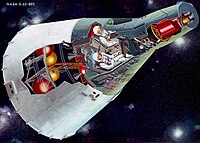 |
Gemini Spacecraft | Gemini Guidance Computer | discrete IC RTL | 7.143 kHz | 19.5 KB | 58.98 lb |
| The Gemini Spacecraft was part of Project Gemini, NASA's second human spaceflight program. | |||||||
| 1961-1972 |  |
Apollo spacecraft | Apollo Guidance Computer | discrete IC RTL | 2.048 MHz | 4 KB (RAM) 73.73 KB (ROM) |
70 lb |
| The Apollo spacecraft was part of the Apollo program, NASA's third human spaceflight program. | |||||||
1970s[edit]
| Year | Picture | Spacecraft | Description |
|---|---|---|---|
| 1971 |  |
Pioneer 10 | The Pioneer 10, which was launched on March 3, 1972, became the first spacecraft to achieve escape velocity from the Solar System. The spacecraft's process were made of individual transistor-transistor logic chips. A common myth is that the Intel 4004 powered the Pioneer 10, however, this is incorrect. |
| 1973 | Pioneer 11 | The Pioneer 11, was launched on April 6, 1973 in order to study the Asteroid belt. Just like it's twin probe, the Pioneer 10, its CPU was also a custom-designed TTL CPU. | |
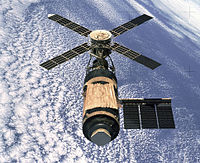 |
Skylab | The Skylab, which was launched on May 14, 1973, and operated until 1979, used an IBM System/4Pi model TC-1 (Tactical Computer), a miniaturized and hardened version of the IBM System/360 computers. | |
| 1975 |  |
Viking 1 | The Viking 1, the first of two spacecrafts, was launched on August 20, 1975. The Viking 2, was launched a year later on September 9, 1975 The computer on-board the Viking Orbiter was the Viking Orbiter CCS, a custom 18-bit TTL computer designed by General Electric. The lander computers, the Guidance, Control and Sequencing Computer, used two Honeywell HDC 402 microprocessors. (A common myth is that the Viking used an RCA 1802, this is incorrect). |
| Viking 2 | |||
| 1977 | 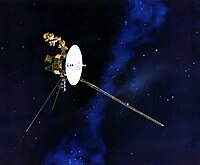 |
Voyager 1 | The Voyager 1 and its sister craft Voyager 2 were launched on September 5 and August 20 of 1977 and are still operating to date (2014). On August 25, 2012, NASA announced that Voyager 1 entered interstellar space.
Each craft carries three dual-redundant computer systems. The first one, the Voyager Command and Control Subsystem (CCS), was in charge of general spacecraft sequencing and general health functionality. The second one, the Voyager Attitude and Articulation Control Subsystems (AACS) used a slight variation of the CCS. The third computer was the Voyager's data computer, which was a custom 4-bit CMOS microprocessor. |
| Voyager 2 |
1980s[edit]
| Year | Picture | Spacecraft | Description |
|---|---|---|---|
| 1981-2011 |  |
Space Shuttle | The Space Shuttles uses 5 identical (for redundancy) 32-bit IBM APA-101S microprocessors. The shuttle system was called the Data Processing System which was composed of Primary Avionics Software System (PASS), that ran in 4 of the computers and the Backup Flight System on the fifth. |
| 1989 |  |
Galileo | The Galileo spacecraft uses the RCA 1802 CPU. |
1990s[edit]
| Year | Picture | Spacecraft | Description |
|---|---|---|---|
| 1990 |  |
Hubble Space Telescope | |
| 1991 |  |
[[Wikipedia:Upper Atmosphere Research Satellite|UARS]. The UARS spacecraft used the NASA Standard Spacecraft Computer (NSSC-1), although the various instruments probably had embedded microprocessors.] | |
 |
CGRO | ||
| 1992 |  |
MSTI-1 | |
 |
SAMPEX | ||
 |
EUVE | ||
 |
TOPEX/Poseidon | ||
| 1993 | PoSAT-1 | ||
| 1994 |  |
MSTI-2 | |
 |
Clementine | ||
| 1995 | MSTI-3 | ||
| 1996 |  |
FAST | |
| 1997 |  |
Mars Global Surveyor | |
 |
Mars Sojourner Rover | 80C85 CPU. | |
 |
Cassini–Huygens | ||
| 1998 |  |
International Space Station | |
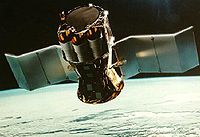 |
SWAS | ||
 |
TRACE | ||
 |
Deep Space 1 | ||
| 1999 |  |
Terra | |
 |
WIRE | ||
| UoSAT-12 | |||
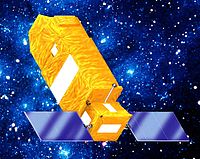 |
FUSE |
2000s[edit]
| Year | Picture | Spacecraft | Description |
|---|---|---|---|
| 2000 | Cluster II | ||
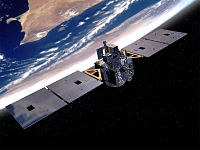 |
MightySat-2.1 | ||
| 2001 | 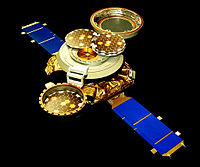 |
Genesis | |
| 2002 |  |
Aqua | |
 |
RHESSI | ||
| 2003 |  |
Spirit Rover | |
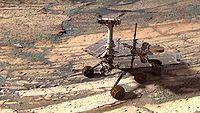 |
Opportunity rover | ||
| 200px | Spitzer Space Telescope | ||
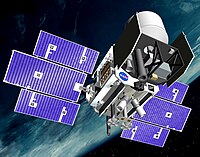 |
ICESat | ||
 |
Coriolis | ||
| 2004 |  |
Rosetta | |
 |
Aura | ||
 |
Swift | ||
 |
Gravity Probe B | ||
| 200px | MESSENGER | ||
| 2006 | 200px | New Horizons | |
 |
STEREO | ||
| 2007 | 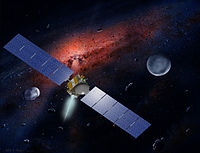 |
Dawn | |
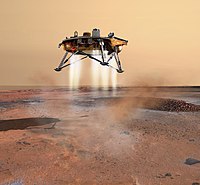 |
Phoenix |
2010s[edit]
| Year | Picture | Spacecraft | Description |
|---|---|---|---|
| 2010 | GSAT-4 | ||
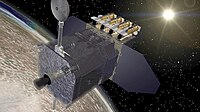 |
Solar Dynamics Observatory | ||
| 2011 | 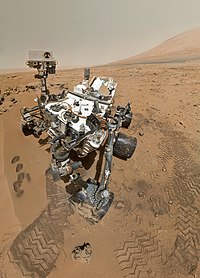 |
Curiosity rover | The Curiosity Rover uses a pair of identical on-board computers called Rover Computer Element (RCE), each with RAD750 CPU capable of 400 MIPS. |
| 2012 |  |
Project Morpheus | |
| 2015 |  |
Triana |